 |
Focus features two in-depth reviews each month of fine art, architecture, and design exhibitions at art museums, galleries, and alternative spaces around Japan. |
|
|
 |
 |
 |
Little Pricks: Chim↑Pom's Cheap Cynicism and Flaccid Social Critiques
Jennifer Pastore |
 |
May, 2020, Tokyo (Hey-rasshai) -- Drawing a Blueprint (2020), installation view |
Excess ain't rebellion
You're drinking what they're selling
-- Cake
Chim↑Pom has been around since 2005, when its six members (Ryuta Ushiro, Yasutaka Hayashi, Ellie, Masataka Okada, Motomu Inaoka, and Toshinori Mizuno) were all in their twenties. The group grabbed the spotlight with performative acts like catching and painting rats a bright Pikachu yellow, or chartering a plane over Hiroshima to skywrite a reference to the atomic bombings. It has received fierce criticism but also popular and critical support, building a reputation over the years while exhibiting at elite galleries and museums worldwide. Chim↑Pom: Happy Spring, a retrospective at Mori Art Museum (MAM) and a satellite site in Shinbashi, presents around 150 works from nearly two decades of activity. The title expresses the sextet's hope for "a brighter spring even amid this seemingly never-ending pandemic."
In its promotional materials, MAM calls Chim↑Pom "Japan's most radical artist collective." Indeed, the group -- whose name comes from slang for "penis" -- cloaks itself in an air of subversion with in-your-face antics that broach social issues like nuclear power, governmental authority, and public vs. private space. At times, its works can be daring, innovative, and meaningful. Take, for instance, Black of Death (2013), when it corralled hundreds of crows from the Fukushima nuclear exclusion zone to fly over the TEPCO Electric Energy Museum in Shibuya, underscoring the power supplier's complicity in the disaster. Still, Chim↑Pom's modus operandi tends to favor attention-seeking spectacle that creates more buzz for itself than any real reckoning with the topics it purports to address.
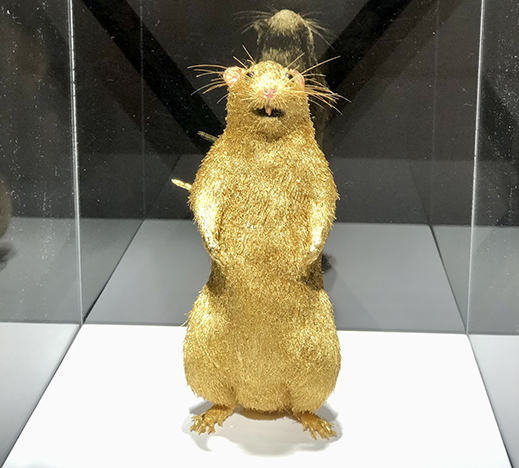 |
|
Super Rat Happy Spring (2022) |
The quote at the beginning of this article comes from the song "Rock 'n' Roll Lifestyle" by the American band Cake. The next lyrics go:
Your self-destruction doesn't hurt them
Your chaos won't convert them
They're so happy to rebuild it
You'll never really kill it
Chim↑Pom has long prided itself on its indestructibility. Text at the Shinbashi space accompanying one of the Pikachu-esque "Super Rats" (a stuffed critter encased in glass and professionally guarded like the Hope Diamond) reads: "They can exclude us, but they can't exterminate us -- we are Super Rat." Chim↑Pom is as bad as it wants to be. Its engine and secret to longevity seems to be a unique brand -- and it is a brand (T-shirts available in the gift shop!) -- of chaos. Here are a couple of the offerings at MAM:
1) The video "Erigero" (2005), which shows Ellie vomiting pink liquid to the cheers of the male members of the group. According to Chim↑Pom's website, this work speaks to "a variety of themes like feminism, the fad of slimming dieting, and the meaning of pink as an attribute of "kawaii" Japanese gal [girl] culture." That's one interpretation. Mine is that it's yet another disgrace celebrating female degradation for the stimulation of men -- an all-too-common leitmotif in Japanese art.
2) The video "KI-AI" (2011), shot in the wake of the March 11, 2011 earthquake and tsunami. Against a backdrop of ruin and debris, Chim↑Pom huddles in a circle chanting slogans like "Radiation is great!" "I want to see cute girls in swimming suits!" and "Fukushima!" in the devastated seaside town of Soma, Fukushima. Whether this footage is tasteless or stirring in its absurdity could be a matter of perspective, but the sarcasm is not particularly trenchant.
Most of us learn in junior high school that obnoxiousness does not necessarily qualify as satire, a lesson that seems to elude Chim↑Pom and its devotees. The jackass/dirtbag aesthetic could be excused by some as a difference of taste, but Chim↑Pom and similar shock jocks become grating when they try to pass themselves off as both irreverent provocateurs and "artists with a serious message." This can be done, but it requires a Swiftian-caliber wit that Chim↑Pom usually falls short of. The posse more often vacillates between the unpalatable and the preachy, frequently hitting both.
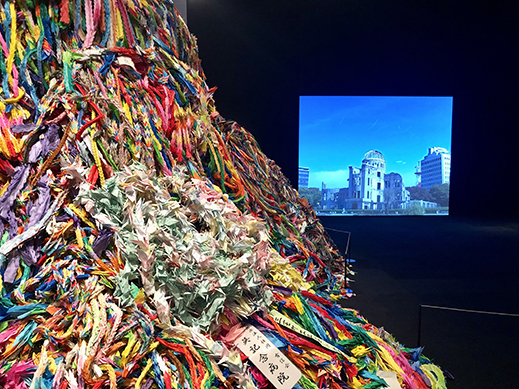 |
|
Pavilion (2013-) in front with Making the Sky of Hiroshima "PIKA!" (2009) in the background |
Let's revisit the "PIKA!" debacle, which is featured prominently in the "Hiroshima" segment of the show. There's a super-sized image of the skywritten word -- which translates to "FLASH!" -- as it lingers over the Atomic Bomb Dome; a wall text detailing the incident and various responses by Hiroshima residents, hibakusha, and critics; plus computer booths for perusing the myriad of texts about the work. Chim↑Pom claims the purpose of the guerilla-style act was to shake people out of "a growing indifference to peace." This justification might hold water had the collective evoked the atom bomb over the homes of ruling-party politicians seeking to scrub the horrors of World War II from textbooks. Instead, however, the grotesque stunt was witnessed by a city once obliterated by an atomic bomb, where there are still living survivors of the atrocity, where any tourist can encounter photographs of charred, mutilated bodies displayed by members of a public still clearly carrying the weight of its aftermath.
Yukinori Yanagi, an artist cited in the debate, writes elegantly: "The pilots of bombers drop bombs from above and don't know what's going on below and they go home on time after work, like an office worker -- that is the way we wage a war today . . . it's a problem of imagination. Chim↑Pom weren't able to imagine what would happen down below when they wrote 'PIKA!' over Hiroshima. They started talking about the memory of the war and apologized only after the fact . . . As it stands, I don't even know what Chim↑Pom fought against or whom they apologized to. Who is the subject of this artistic act?"
I partially disagree with Yanagi, however. I think Chim↑Pom could very well imagine the controversy-fueled attention its "artistic act" would bring. The group has in fact apologized to atomic bomb survivors, befriending a few and collaborating with the Hiroshima community on art projects, some of which can be seen in Happy Spring. But whether it has truly atoned for "PIKA!," or learned anything from it, is a murkier matter. There may be those who give the group credit for not trying anything similar -- like, say, filming Tohoku residents in an earthquake simulation machine (never forget!). However, if an artist truly regrets a work, if it fills him with remorse, does he then continue to exhibit it, giving endless explanations and stirring debates about its pros and cons, especially if it has already -- as demonstrated -- been extensively discussed?
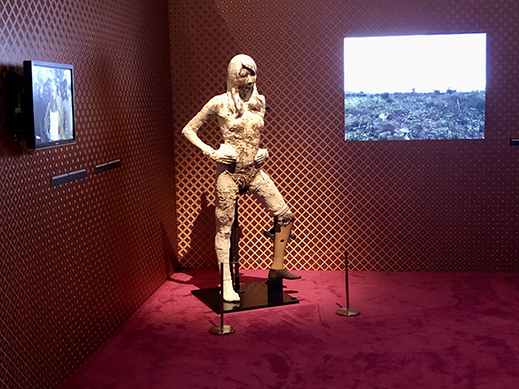 |
|
Thank You Celeb Project -- I'm BOKAN (2007), installation view |
Chim↑Pom likes to take its act on the road. For Thank You Celeb Project -- I'm BOKAN (2007), Ellie created a statue of herself to be blown up along with a few luxury goods in a landmine-clearing mission in Cambodia. She then sold the exploded items and their fragments in a Japanese charity auction with proceeds going to Cambodian aid efforts. The project supposedly questioned "the economic disparity that exists between developed and developing countries, as well as the close relationship between art and capitalism." But how exactly these questions are raised and what answers we're supposed to find in them is unclear. As for the Cambodians, I suppose they appreciated the cash, but they probably could have done without the showmanship in the name of what exhibition materials call "noblesse oblige."
A Drunk Pandemic (2019-2020), installation view |
Other international trips resulting in works of self-important "consciousness raising" and paltry attempts at satire include excursions to Mexico and England. During the former, Ellie tells a Tijuana slum resident that she's just like her because neither of them can cross the border into the United States. (Ellie was denied entry because a member of her entourage joked about having terrorist associations; play stupid games, win stupid prizes.) For the latter work, A Drunk Pandemic (2019-2020), Chim↑Pom manipulates the image of a real cholera victim so that she robotically bleats "A drunken pandemic has the most exquisite taste -- yay." Just after this display awaits Gold Experience (2012), a bouncy house in the shape of a giant black trash bag that visitors can enter, to "become" garbage rather than just producing it. These attempts at black humor are obvious and enervating, the kind of bad joke you only laugh at to help the teller save face and keep the party afloat. Of course, there is such a thing as gallows humor, but as the writer Alexandra Erin has pointed out, its success depends on the joker being the one on the gallows. If she's in the crowd, she's part of the execution. A major problem with Chim↑Pom is that it tends to play the role of executioner while trying to pass off the gallows itself as a joke -- or worse, as a work of art.
 |
|
A Street (2022) with Gold Experience (2012)/2022), installation view |
As I mentioned earlier, not everything Chim↑Pom does is terrible. The "May, 2020, Tokyo" segment of the exhibition displays interesting (and for Chim↑Pom, rather understated) billboards covered in cyanotype sensitizer to create "blueprints" of the city at the start of Tokyo's COVID-19 State of Emergency. In the same room, life-sized photographic cutouts of participants in Ellie's public wedding procession make for an energetic scene that conveys Chim↑Pom's knack for exploring the boundaries of public and private space. Another key work surveyed in the show is Street (2017-2018), a 200-meter asphalt road Chim↑Pom built to connect the inside and the outside of the National Taiwan Museum of Fine Arts. The group negotiated with officials to allow for protests and parties in this "alternative public space." MAM takes a stab at a new version of this installation with its own blacktop, A Street (2022). The pavement is again open to public projects, but contained within the museum this time, it feels sadly sanitized.
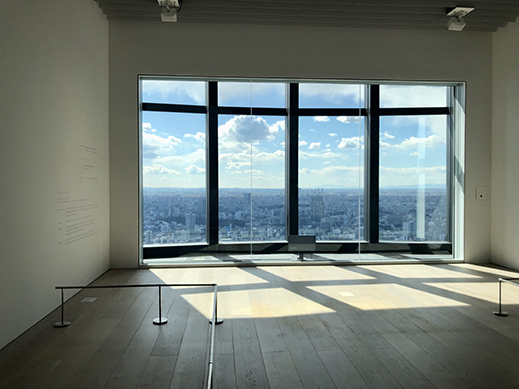 |
|
Don't Follow the Wind (2015-) in Chim↑Pom: Happy Spring at Mori Art Museum (2022) |
Don't Follow the Wind (2015-), an ongoing exhibition inside an area of Fukushima Prefecture evacuated due to nuclear contamination, may be Chim↑Pom's most ambitious undertaking. It consists of works by a dozen artists that the public cannot view until entry restrictions are lifted. When this will happen, if ever, remains unknown. MAM's representation of the project involves an empty room with enormous windows looking out on the Tokyo skyline from the 53rd floor of Roppongi Hills Mori Tower. The elegiac sensation of staring at the urban expanse while listening to recordings of Fukushima evacuees telling their stories is undeniably powerful. That feeling, however, is disrupted by the realization that the metropolis, skyscraper, and the very exhibition providing the experience are all fueled by the same energy-hungry cycle of consumption that cost the speakers their homes. Perhaps this discomfort is by design -- but if so, Chim↑Pom has not sufficiently addressed the contradiction, or transcended its own entanglement in it.
Words from the late, great critic bell hooks: "When we only name the problem, when we state complaint without a constructive focus or resolution, we take hope away. In this way critique can become merely an expression of profound cynicism, which then works to sustain the dominator culture."
I do not think artists necessarily need to solve the world's problems. It can be enough to shine a light on them -- that's a crucial first step. But it's important to note where that light is coming from and just how much it really illuminates. Two contemporary artists making consistently excellent work about disaster, war, and the paradoxes of modern life who deserve more attention are Bontaro Dokuyama and Kyun-chome (Nabuchi and Eri Honma). Like Chim↑Pom, they also create videos, installations, and performances, but whereas Chim↑Pom concerns itself with antihero posturing, Dokuyama and Kyun-chome produce pieces that compel you to watch longer, think harder, feel deeper. Theirs is an art that cannot be so readily consumed and discarded.
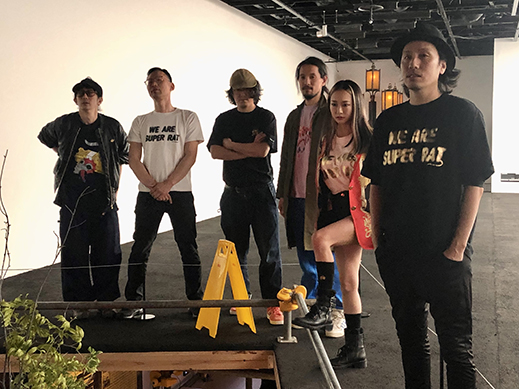 |
|
Posing like rockstars: Chim↑Pom at Happy Spring |
All works shown are by Chim↑Pom; all photographs are by Jennifer Pastore, courtesy of Mori Art Museum. |
 |
 |
Jennifer Pastore
Jennifer Pastore is a Tokyo-based art fan and translator. In addition to Artscape Japan, her words have appeared in ArtAsia Pacific, Sotheby's, and other publications. She is an editor at Tokyo Art Beat. |
|
 |
|